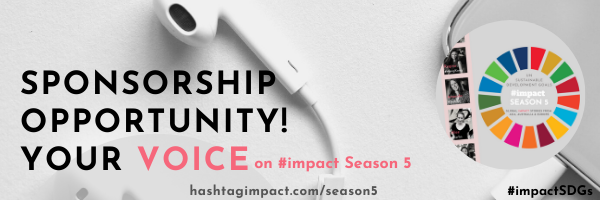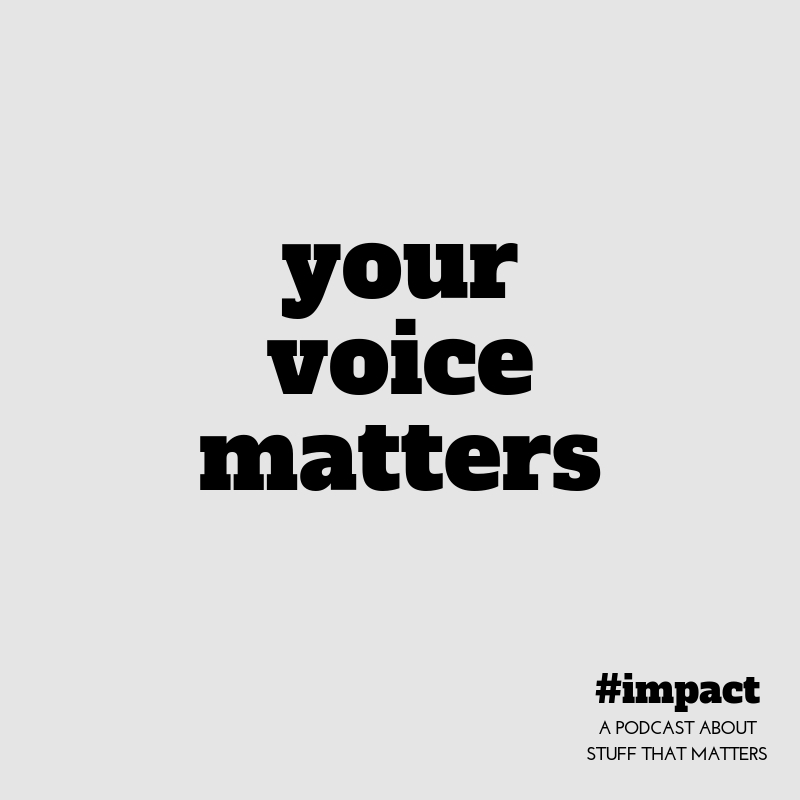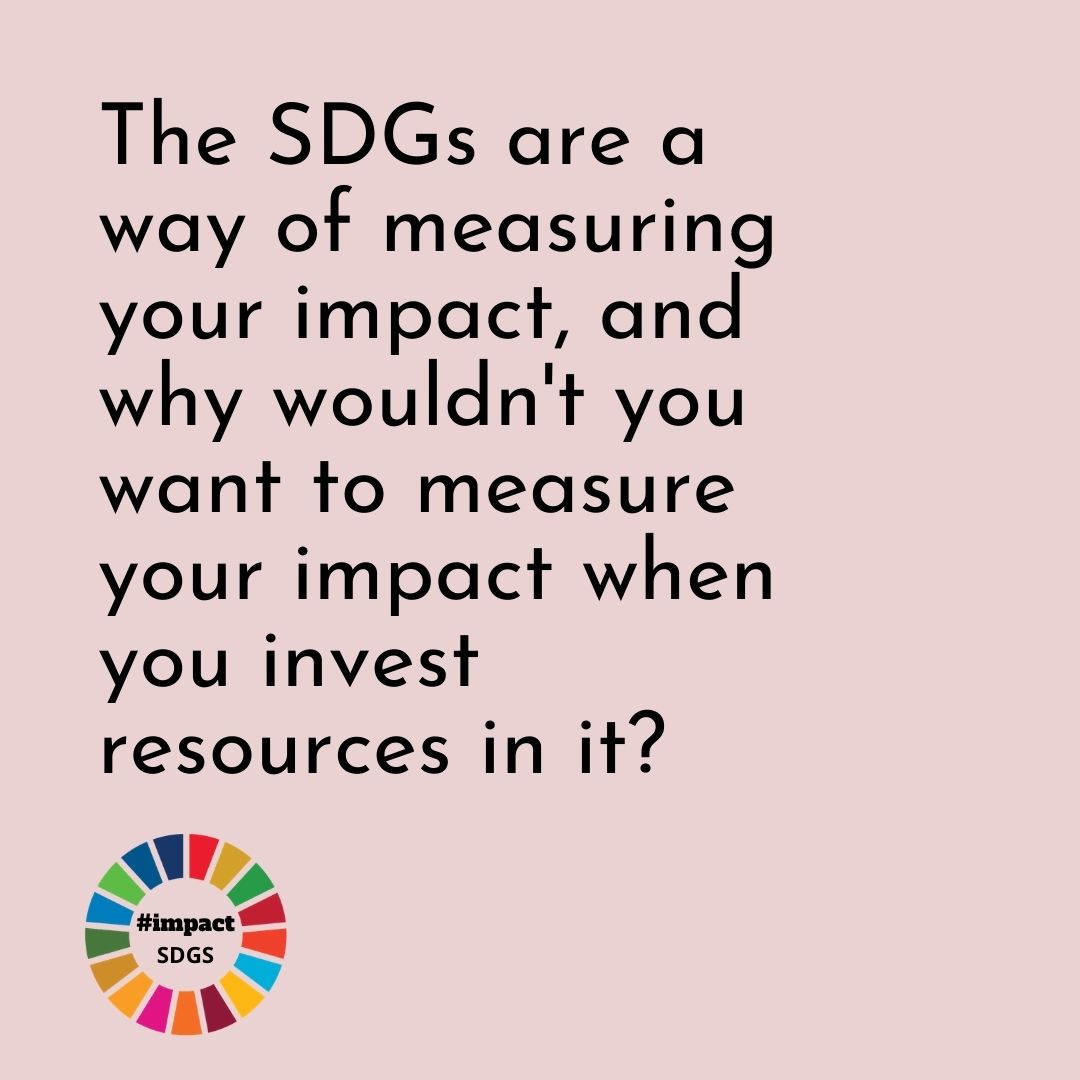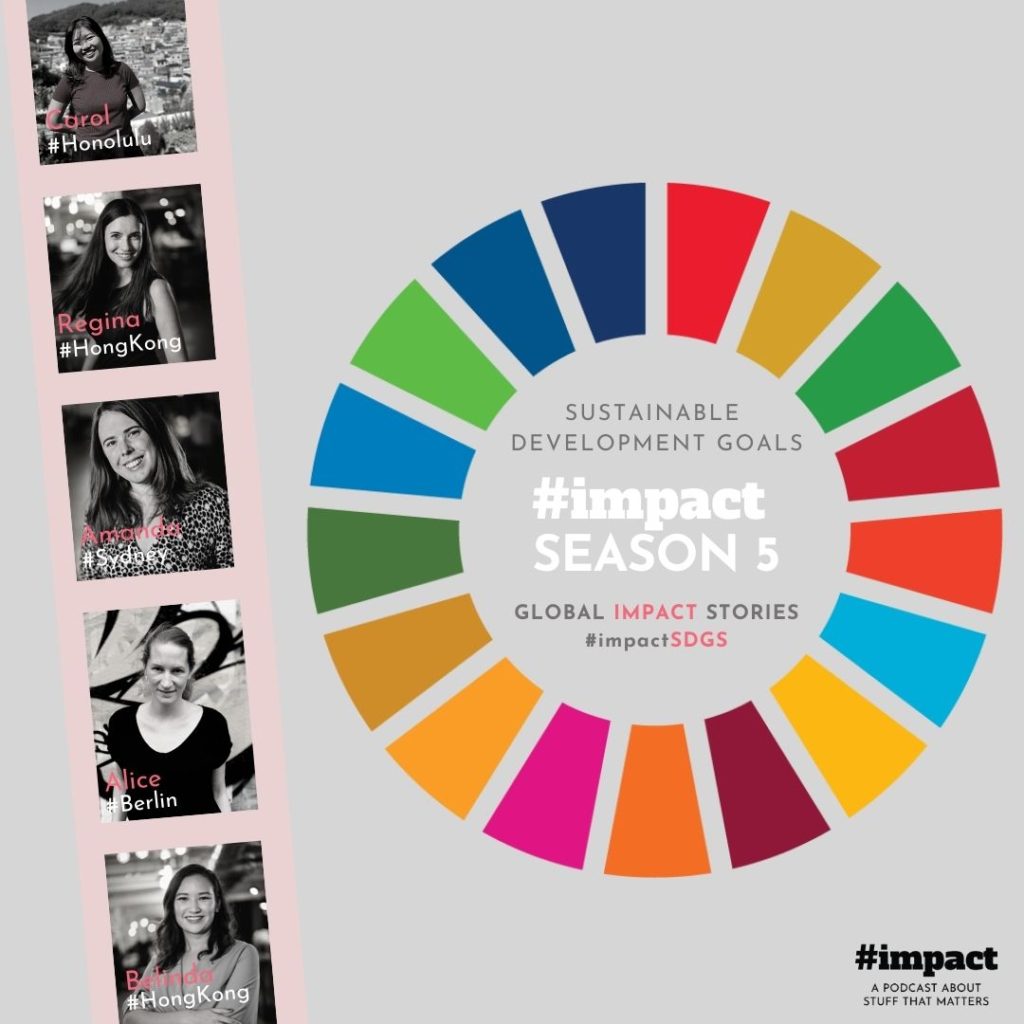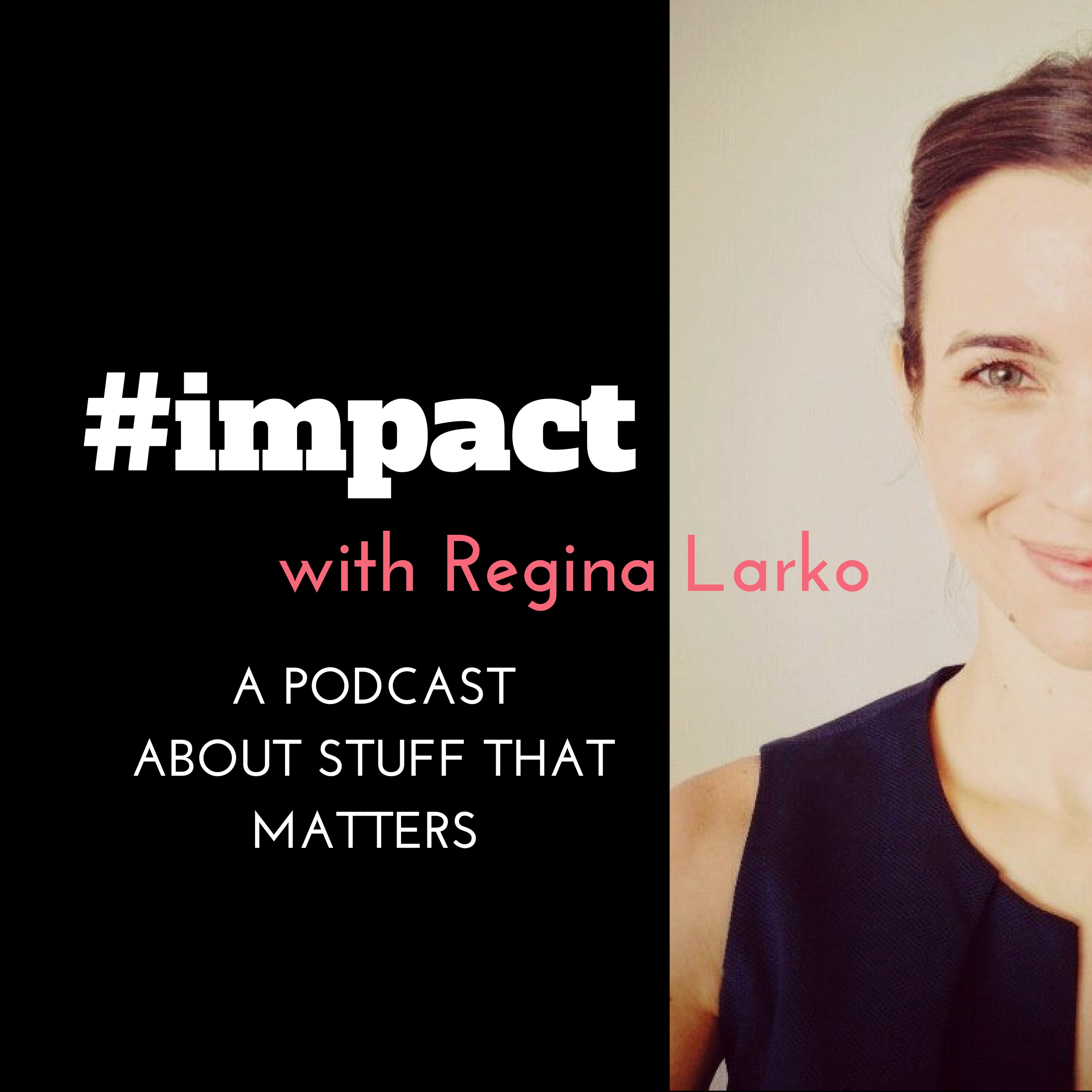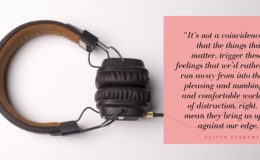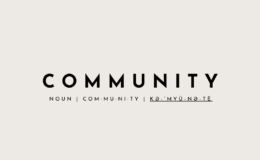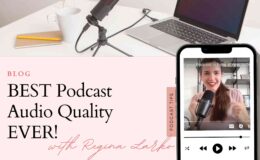Full Transcription of our conversation with Pat.
Regina Larko 0:00
Today I am sitting down with Pat Dwyer, founder, and director of The Purpose Business. I have to tell you, first of all, how I came across her work. I saw Pat speak at an International Volunteer Day celebration that was organized by HandsOn Hong Kong, a local charity here in Hong Kong, that empowers everyone to volunteer. And I sat in the audience with a big baby bump, expecting my third child. And I was also anticipating a new season ahead for the #impact podcast. You know, this famous saying by Maya Angelou, I am sure you do, when she says that you don’t really remember what people say, but you will remember how they made you feel.
And well, your speech, Pat, and I told you that a few times now, it really lit me up, because I loved your optimistic realism, encouraging, especially corporates to lead with purpose and truly committing to the SDGs. Not just by putting a banner on their website, but by actually strategically integrating the SDGs into their company’s DNA. So this was in December 2019, that I saw you speak Pat, before the first cases of Covid-19 were reported. So Pat, over to you, how do you feel about the Sustainable Development Goals today? In late 2020, after this crazy year, we’ve had.
Pat Dwyer 1:49
My goodness, Regina, first off, thank you, and I can’t believe that it’s been that long. It’s almost a year since that event and wow, what a crazy different year we are in. Most people will say we’re, you know, humanity was tested and we’re broken. And we’ve never been down this road before. This is the great COVID depression. But thank you, I’m glad you recognized the slight optimism in the way that I handle things because forever the optimist, I do try and look for the silver lining, which is very, very hard when we all have our own personal stories with COVID too, but to try and see where sustainability is just because of our context today, I think what we’re holding is we’re all grappling for hope.
And we’re all looking for where the light is gonna shine again. And a lot of people have asked me this beginning of this year when you know, you have it in stages, Asia was hit then Europe and the US in then back around again, you know, you must be struggling because sustainability is such a hard sell. And, you know, no one has money or budgets or time for sustainability. And I always said, if anything, it’s almost like we were forced to go back to our rooms, we were locked in there for a while literally. And, and we were asked to rethink the most basic things in life and the most important things that we probably forgot. Anything from growing your own herbs to having more time with family, to just appreciating nature that comes back outside us to not flying. And I would argue that that is all about the future sustainability of our lives and of our fellow beings, not just people, right, so COVID has done that.
It has forced us to take stock, it has forced people to watch more David Attenborough films, it has forced us to rethink why you would get on a plane just for a one-day meeting sometimes for a three-hour meeting. And I really hope that we won’t easily forget. Because we could easily go back to again, we’re back to flying Hong Kong and Singapore bubble is now open. Let’s just do our weekly meetings there. I really hope we take something away from this. And I think that is why I’m passionate about the SDGs when they first came up in 2015 because it just represented how complex the world has become.
And the world that was with the Millennium Development Goals with less than 10 goals, it was eight goals then, fighting extreme poverty, malnutrition, education. Those where I don’t want to belittle it and say they were basic problems. But when you have the reason for the awkwardness of the 17 it’s actually because nothing was certain and nothing was orderly with the issues. You know, it just shows you the complexity of the world that we live in. Where Yes, you’ll have gender equality, but you also have industry innovation and infrastructure, which is Goal 9. And then you’ll have things like, you know whether it’s a straightforward goal dedicated to climate action. But when you look at what that demands of governments of companies of organizations in general, it’s so, so, so complex, and it represented the world in 2015, going into 2030.
But today, 2020, 10 years down the final goal of the 2030 agenda, we are even battling more of the symptoms of that complexity of the world and the excitement on our part is to see how far along can we really change because we only get one shot.
We all say, you know, this is the world that our generation can act on. I don’t want to look back when I’m 70, or 80, or 90, or whatever age I can look back from and say, I got a chance to do something and I did it. That language is so real with COVID, where we got a gap year, a gap year that is 2020. And this is the year where you can do all the things you said you would do when you had a bit more time. And imagine 2023, and you’re looking back to 2020, you still don’t get to do what you were supposed to do, if that just means calling your grandmother more often.
And so the SDGs are really very personal. The Purpose Business I set up after having left the Shangri La as a Global Head of Sustainability for about seven years. I set up The Purpose Business in 2015 and the Global Goals came out in 2015. And it was actually one of the first events that we hosted in Hong Kong and then later on in Manila because we wanted to bring awareness.
This was “Leave no one behind” was the mantra of the 17 goals because this really required action across everyone. And for the first time you have the UN steering a movement that wasn’t just crafted by governments and civil society, which is usually its primary stakeholders, you actually had business coming into the fore.
And it is the responsibility of business to operate sustainably, not just profit sustainable, but socially and environmentally sustainable.
Because let’s face it, we use the very resources to turn them into products and services, right. And that’s why corporates should be implemented around the SDGs. Now, when we unpack the SDGs, yes, there are 17 goals. But there are 169 targets and 269 or so indicators under all the goals. So what is slightly disappointing sometimes is it’s a wheel coloring exercise for most organizations, you know, you work in fisheries, and so you will put Goal 14 there “life below water” because of course, you support marine protection. But how do you support marine protection? The KPI, if we were to leave them within any organization is the measure by which we would look at our progress. We’re obsessed with KPIs even when it comes to your personal budgeting at home, you know what the budget they have to stay under and all that.
So it’s no different from the global goals. Yes, there are 17 colourful goals, but behind each goal, our KPIs goals and indicators, and that is the level that business should be really looking at.
It’s not enough to say, we support marine protected areas, and therefore we deliver on life mineral water, I want to know how, because by 2030, we want to see that X percent of the fish stock was restored, that X percent of endangered species were probably not reduced itself from being critically endangered to a little bit more refurbishing and regenerative.
And so my ask of corporates, and this is what we do when we speak to our prospects and our clients are to really think about the goals as a business framework.
Also, quite interestingly, when you do that, they understand the goals better, because right now, it is a belongingness exercise, you support the goal if you splash it out on your reports and your websites. And yeah, we support the goals but nobody really knows how you do it. The minute you drill it down to the KPIs and indicators, it helps to be able to track you know, that old adage of cannot manage what you don’t measure.
This is giving you that measure, but you will only get that measure when you get down to the level of the KPIs. That’s hard because the last thing you want is another framework. But the truth is the frameworks actually now do speak to each other. For those in listed companies who follow a variety of sustainability for works in reporting, the SDGs lend themselves to that, and if at all, the SDGs are just a way of measuring your impact, and why wouldn’t you want to measure your impact when you invest resources in it?
So I think both personally, there is a resonance there. But also as organizations, whether you are business, whether you’re NGOs, social enterprises, there are schools and churches that have aligned with the SDGs. And that’s really interesting because it really calls upon any organizational entity to enact it. And that excites me.
Pat Dwyer 13:05
Well, it starts with them, I guess, having a little bit of awareness of needing to do something. Thank you for the shout out on the report. The report is actually one that we’ve been watching since last year. So one could argue this isn’t a COVID,post-COVID Pro recovery report.
This is just even without COVID, I think our findings would have still held true. And what we say in the report is, this was actually a response to a finding towards the end of 2019, where Asia is on track to miss all the goals, this came out of the UN reviews.
And the question there was how is Asia going to make it because we have 10 more years. And you know, in a way, a target and a deadline are dates that we put in the diary, whether you miss it or not, you know, sometimes you can forgive yourself, but there are lives at stake. If we don’t decarbonize significantly by 2030.
There are lives at stake if girls don’t get access to schooling in 2030, we can’t still be in that narrative. And so what the report tried to show, and nowhere is this report a blanket statement for Asia. You know, we’re not resourced to do a full Asia wide report. But we did take buckets of Singapore, Hong Kong Philippines examples of Indonesia, Thailand, looking at some of the companies and the work they do around the SDGs. The big findings that we had been that if you focus on three, decent work and sustainable economic growth, Goal 8, responsible consumption and production Goal 12 and life underwater Goal 14. If you focus on those three, of course, to the extent that it is appropriate to your business, there is a better chance of hitting some of the other goals along the way.
And the question really here is understanding your business impact and then the priorities that come with your most material issues. So it is daunting. And this is why companies don’t even come anywhere near the targets of the indicators.
Because to have to swim through 269 of them, that’s just too much information, I get that, I’ve been in house Sustainability Officer myself. But when you know the company, if you’re in the food and beverage sector, and you make beverages, then clearly, you have impacts on natural resources, likely to be anything from water, which is the most basic ingredient of any beverage, and then whatever it might be coffee, chocolate, tea, whatever the drink is, right.
And so there are already obvious ways that you can look at your impact. And in the world of sustainability, we call this materiality. And so this is our starting point with companies when they say which of the SDGs should I focus on, just because I’m a transport company doesn’t mean I’m just going to go for climate action because that’s obvious, you probably will go through and go for climate action.
But you probably should look at decent work and access to decent work if you have contracted workers. And let’s say, and you will only know that if you do a proper materiality assessment and really map the most important issues. Because we’re also not asking you to undress gender diversity, life below water, your energy consumption, and go for partnerships all at the same time, we’re just doing what we can.
And so you start with the areas of your biggest impacts and your areas of biggest positive impacts. And so when we work with companies, it’s building on their materiality assessment, which many of them would have done one way or another, it’s just the depth that we’re chasing. And then creating KPIs to measure the various targets that you’ve had.
Because remember, especially in Asia, the sincerity and authenticity to do good are there. Not to say that in the West, it isn’t. But it’s ingrained because of family values, because of the cultures that pervade Asia. And so they naturally will do the right thing anyway. But measuring the impact of that, you know, you build classrooms, and you support education because it’s the right thing to do. But you’ve never had to measure the impact of that financially like you would with the same acumen in business. And there’s a shift there.
And so we invite companies to be implementing the same rigour, the same obsession with progress, and in fact that they would be on their p&l as they should be on sustainability issues.
And then when you map the goals and the targets, it makes it easier to manage, because there’s also a rationale as to why you’re not doing certain things.
And so if you are a food and beverage company, and you prioritize life, on land, climate action, responsible consumption, and maybe access to clean water, and those are your three or four, then great, I can understand that I am not going to expect you to as well manage go for quality education or Goal 1 poverty, they could be secondary goals that you push for. So we do encourage companies to zero in on a handful.
And by a handful, I don’t mean five fingers, actually, you know, three or four, as we know, is already a lot. So that’s how we would work with them. And then the tracking, and also the promotion of education and awareness. So the session that you went to last year is just one of the many ways that you could understand what really the SDGs could do.
And we are so lucky that everything that the UN and all the partners around the Sustainable Development Goals have already created a classroom that is open source, all the logos, the materials, the language, everything has been translated in so many languages that you could actually run this in terms of presentations, you could run this in terms of educational programs, you could run this in terms of employee engagement activity.
So there’s so much material there that you could use. I don’t see any reason why it should be expensive to train your employees, your staff, and your organizational peers on anything on the SDGs.
Regina Larko 20:46
A fantastic way to educate and train yourself as well as your team, friends and family on the SDGs is to listen to Podcasts. I listen to so many Podcasts and I want to highlight Podcasts that have been particularly helpful to our team as we are curating the stories for our ongoing Season.
One of my favourite shows discussing the Sustainable Development Goals is Global Goalscast run by Claudia Romo-Edelman and Edie Lush. I particularly love that they bring in several experts for each episode and I learn so much in every single one of their shows that are always so well researched and fun to listen to as you get to know the Edie and Claudia better as well.
One of my favourite episodes is the one called “The crises of the Global Goals. Can compassion at scale put the SDGs back on track?”
Another Podcast I want to highlight today is the Social Entrepreneur Podcast by Tony Loyd. How to use business for good that’s what you will learn in this show and so much more. I can highly recommend also to scroll back to earlier episodes.
My personal favourite is the one featuring one of my biggest radio role models Krista Tippett, the host of the On Being Podcast. When she shared with Tony about how she launched a social enterprise with a radio show at its heart.
Just google Social Entrepreneur Podcast and Global Goalscast and you will find their websites. I will also add a link to the Podcasts in today’s episodes show notes that you can find over at www.hashtagimpact.com/season5
Even with all the Podcasts, I listen to, there are still questions marks when it comes to the complex topic of the SDGs and as we jump back into the conversation with Pat Dwyer from The Purpose Business we will get them all answered.
Pat Dwyer 22:57
It is really a lot of questions in terms, how do you get started? Which one do you prioritize? How do you not get overwhelmed, and you can imagine that something like this cannot be prescriptive to the t.
And I’m empathetic to the United Nations in terms of keeping it as broad as possible, it has to be, you cannot legislate to the level of the micro-industry and the organization that is there.
But it’s generic so that it brings everyone along again, “leave no one behind” is the mantra, right.
So it has to be applicable to a teacher who just wants to make a class fun all the way to a group of fishing cooperatives that are trying to lobby for protection on how they keep their livelihood all the way to a big family conglomerate that is multigenerational or a national government that wants to stand for new infrastructure.
So yeah, we’re straddling a whole lot of stakeholders. So the question being is that is so broad, how do you know what’s right for you? Well, you need to know what’s right for you first, you need to know you. And like any other individual, you need to know what’s important to you what it is that you do, what’s important to your family. And that’s how the SDGs will resonate with you.
It’s the same principle behind materiality for companies, you need to know where your operations are, what your impacts are, and what you would prioritize. So I think, focus and prioritization would be true, regardless of who the subject is, whether it’s a parent or a conglomerate. In my personal life, I obviously work in sustainability longer and so the pressures are real.
You know, I remember when I was working in Shangri La, they would tease me if I jumped in a taxi because, oh my god, you know, “Miss Green” “Miss Eco” is jumping on the taxi. Well, I’m also the only human that needs to be in a meeting and 10 minutes.
So you know, to the extent that you can make life choices, then you would do so. Where you can make an impact. And it’s a conscious choice. This is the number of people who have shifted to Green Mondays, or, you know, two or three meals in a week that are more plant-based. They are consciously making their, their own parts. And I think you have to know as a mother of three now what is important to you and what kind of rearing and what kind of clothes and what kind of toys and what kind of educational materials and what kind of world your kids are going to be growing up. And I’m sure that is an everyday renewal in the contracting of being a parent.
As opposed to individuals who perhaps like myself who do not have kids and so our priorities and our focus may be different, in my case, whether that’s offsetting your flights or whether that’s using my voice to educate others a bit more, I feel personally responsible for doing things like this one, you know, like this talk or that one with HandsOn, because if I can help bring it to life. So on the side outside consulting with clients, I also work with an NGO called Enrich, which pushes for financial literacy of migrant domestic workers.
Regina Larko 26:05
We had them on the show. They are they are amazing. And I’m gonna, yeah, link that episode also for our listeners, so they can also listen into the impact that they are driving here for a very vulnerable community.
Pat Dwyer 26:21
Correct. It’s a vulnerable sideline community that actually delivers three, four percent of Hong Kong’s GDP if we were to be so prescriptive and accounting of it, and yet they do not get access to whatever government subsidy for COVID. They do not get a decent place to live, they do not give permanent residency, right.
So as a Filipino myself, I know their plight, and I feel very responsible and living out one of the goals or if not a few of the goals, if it’s fighting poverty, if it’s ensuring that, you know, there’s not, not gender diversity, but reduced inequalities in general, which is Goal 10.
If you think about what kind of support they deserve, when, when these 390,000 helpers have allowed families to work double-income households, and you look at children who have been reared by nannies, but also the elderly, having a bit more bearable last few years, also Animal Care being supported, because, you know, you have a helper that is able to walk it I mean, all of these are privileges living in a city like New York, Dubai, Singapore, Hong Kong, and you got the helpers, supporting.
So on a personal level, I think you have to look at what your values are, what your priorities are, what you stand for, and you make a conscious effort in supporting them, however, your voice counts.
And I think the biggest thing around here is we don’t talk about it enough. It’s interesting in 2015 when this rolled out, I think it was Indonesia, and some of these public schools in Indonesia, who have immediately taken this to do an exercise with children were in the morning after their morning prayers, whatever the school, the National Anthem, the announcements, they actually played games around the SDGs. Because they were sensitizing children at the ground base level of education, what the SDGs are, and you ask any child right now, this is part of the curriculum one way or another, there’s something about recycling. There’s something about climate change.
There’s a school down here, I think, next to the St. Paul’s convent, in Causeway Bay, whose windows are coloured with the SDGs. And you ask the students, they actually have done a subject around it again, not in its entirety. So I think Gen Alpha, I think they’re called, kids below nine or 10 already know this more than any boardroom in Hong Kong or Singapore, and that is staggering to me.
Because that’s really where it starts, media has to do a better play around promoting it. But we ourselves have to also talk about, you know, even just one of the goals and find the goal that really resonates with your values and what it is that you’re impacting and what you do, and then talk about the one thing that you are doing about it, whether that’s participating in beach cleanups, whether that’s a plant-based food, whether that’s supporting upcycle materials, whatever floats your boat, I think we all have a part to play.
Regina Larko 29:34
That’s such a great call to action. Pat, thank you so much. I know you have a million things piling up on your desk and I’m so grateful that you took the time to share with our listeners from your experience. But I won’t let you go before you go through the quickfire round with me. It’s 3 questions where I will ask you for quick answers. Are you ready for it?
Pat Dwyer 30:03
Ready as I’ll ever be.
Regina Larko 30:06
Pat, making an impact means…
Pat Dwyer 30:10
Leaving an imprint in the world
Regina Larko 30:15
Who inspires you in the way they tackle the Sustainable Development Goals?
Pat Dwyer 30:21
I’d say the helpers that I show up for since we talked a lot about that. And that’s top of mind right now.
Regina Larko 30:29
And the biggest and for me, most important question of all that I want to leave my listeners with, what could everyone do right now after they listen to this podcast to make the world a better place.
Pat Dwyer 30:46
Speak to a loved one, a partner, a friend, a person that is so important to you, and really talk about what your values are, and then pick an action point from there. I mean, if that lands you on the SDG website, then great, but I’m not going to say this the SDG website. I think to talk it out with someone in your family or someone in your team because your individual actions count.
But when we move as a collective as a network of positive forces, we are so much stronger.
Regina Larko 31:19
I love that. Thank you for inspiring our listeners. And I also want to send them over to your site now. So they can also check out that report that we mentioned. Where should they go if they want to get in touch with you and want to learn more about what you do at The Purpose Business?
Pat Dwyer 31:37
So that’s www.thepurposebusiness.com that is our website. And we help companies be more reflective of what the impacts are of their products and their services.
We help embed purpose in their action, but also activate it. And when you activate purpose, you will end up with responsible leadership. You will find ways to do better and show up for your shareholders, for your rest of your stakeholders, yourselves, your suppliers, your employees, and I think this is it. Nobody wants to be in a business that takes away. We are in the business of making, of creating, of producing. But we want to do that in a manner that restores a little bit of the environment we have taken from.
Regina Larko 32:27
I couldn’t think of a better way to wrap up this episode. So thank you again, Pat.
Pat Dwyer 32:33
I could talk to you all day though, Regina, so thank you for this.
Regina Larko 32:36
Thank you and we will make sure to check in on what your team is doing. I’m sure there will be many more amazing reports coming from your desk as well. So we’ll make sure to check in and also keep sharing with our listeners the updates from The Purpose Business.
Pat Dwyer 33:56
Fantastic. Thank you so much for having me.
Get in touch with Pat.
- Official Website of The Purpose Business.
Helpful resources to educate yourself on the Sustainable Development Goals
Get notified when our next episode airs!
